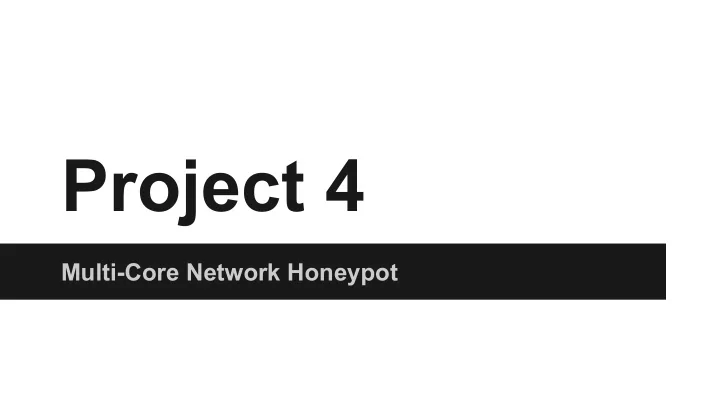

Project 4 Multi-Core Network Honeypot
LL/SC - Important for mutex locking/unlocking - Crucial for synchronized data-structures - Up to 32 cores in PA4
LL/SC Syntax ● LL a, off(b): loads M[b + off] into register a ● SC c, off(d): ○ Attempts to store the value of c into M[d + off]. ○ If M[d + off] has changed since the last LL instruction then c = 0 and M[d + off] stays the same. ○ Otherwise M[d + off] = c and c = 1
High Level Overview You are to design a network honeypot : ● receives packets from of a network device ● analyzes and classifies those packets ● tracks various statistics over time Your honeypot will be simulated on a multi-core MIPS and simulated I/O devices.
Project Goal - Bundles of data = “packet” - Max size of packet is 4kB - Receive packets as fast as possible (maximize throughput) - Analyse all packets and gather statistics
Important Files After you have read through most of the code that we give you, your focus should be on: - kernel.h/c - network.h/c - honeypot.h/c If you feel overwhelmed, don’t worry: you will not have to touch most of the other files.
Packets Three categories: - Vulnerable, spammer, evil - Command - Print Detailed descriptions of each packet category is on the main project page.
Interrupts - One of the two main ways to handle packet reception. - Interrupt occurs when packet arrives - Simple implementation (may or may not be easier than polling) - Slow and will result in poor performance during network spikes
Polling - This is the second way to receive packets - Checks continuously if a packet arrived in the “packet ring” (explained later) - Needs a core on polling duty - Very fast and not a bottleneck if implemented correctly
Packet Ring ● Array of 16 (address, length) tuples in memory ● Has a “head” and “tail” (essentially a ringbuffer) ● When packet arrives, ○ it will be written to paddr in the tuple under the head ○ head moves to the next tuple ● Make sure the memory where the packet arrives is allocated
Packet Ring (continued) Packet Ring head ( paddr , len ) Memory
DGB2 Hashing - Same as for your hashtable - Takes in a pointer to a sequence of bytes - Returns an unsigned long - You need to use this function on every packet
DGB2 (continued) - Very time consuming - Is the bottleneck in functioning systems - Hard code some of it - Unroll some of the loops (see FAQ) - In sum: optimize it as much as you can
Milestones - Start the project ( seriously this time, start this early…we are not joking, and there are no slip days) - Turn on simulated network card and receive/drop packets - Prepare Design Doc meeting - Receive first 17 packets without dropping - Handle one of each type of packets
Milestones (continued) - Implement and synchronize shared data-structures - Synchronize malloc / find a way around it - Print out statistics - Parallelize analysis of packets - Optimize until due date
Expectations - The measure of how good your final project is throughput (bits worth of packets you can analyse per unit time) - You need to be dropping very few packets - Aim for 10 Mb/s (don’t panic with lower throughput) - Highest ever is 61 Mb/s
Due Dates ● Schedule Design Doc meeting - May 3rd ● Design Documentation - May 7th ● Schedule Final Presentation - May 10th ● Final Presentations/Demos - May 13-14th ● Final Code Submission - May 14th
Suggestions 1. We cannot emphasize this enough; get started early: there will be fewer people in office hours further away from the deadline. 2. Keep your code clean: your codebase will be significantly larger than any other project for this class. Make sure you can read through it. 3. Version control: this should be a reflex by now, there is no reason not to do it. Keep it private (e.g: bitbucket).
Recommend
More recommend